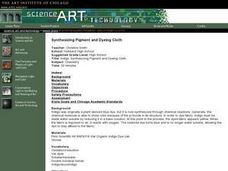Curated OER
Science with Mud!
Eighth graders give some examples of chemical reactions they see everyday. In this chemistry instructional activity, 8th graders investigate how much water soil can hold. They collect data and compare results with others.
Curated OER
Solar
Pupils study solar energy. In this renewable energy instructional activity students complete several lab activities using different controls and variables.
Curated OER
The Great Gas Race
Fourth graders improve their understanding of Graham's Law by using properties of gases to evaluate the rate of effusion of two compounds as they vaporize. They engage in a lab which elevates their understanding of the properties of gases.
Curated OER
What is Matter?
Students investigate what matter is and how it changes states. In this physical properties lesson, students examine the vocabulary database and identify the characteristics of the three phases of matter. Students perform a...
Curated OER
Animals of the Fire Ice
Learners examine ocean life by identifying methane hydrates. In this ocean life lesson plan, students research organisms that live in the coldest, deepest parts of the ocean and live off methane hydrates. Learners create a...
Curated OER
Biodegradability
Students study the effects of water, salt water and heat on common household materials. They separate an emulsion and show that the materials are completely recoverable and observe the effect of acetone and water on polystyrene.
Curated OER
Water and Polymers
Students conduct qualitative and quantitative investigations based on the interaction between water and various polymers. They determine the percent moisture contained in various plastics along with a qualitative procedure to determine...
Curated OER
Intrinsic Viscosity
Students treat a high molecular weight polyvinyl alcohol polymer with potassium periodate. They measure the viscosity of polyvinyl alcohols.
Teach Engineering
Making Model Microfluidic Devices Using JELL-O
Nothing flows like J-E-L-L-O! In the final portion of a four-part series, pupils create scale models of microfluidic devices out of gelatin and bendable straws. They use their devices to test various flow rates in the delivery of...
Curated OER
Animals of the Fire Ice
Learners study ice worms and describe how they interact with other species. In this methane hydrate instructional activity students study ice worms and hydrate shrimp to learn their behavior and can participate in an optional...
Curated OER
The Influence of Carbon Dioxide on the Chemistry of Soda
Students investigate the carbon dioxide content of different sodas. In this chemistry instructional activity, students explain why PET containers are preferable than HDPE for soda bottles. They collect data and graph them.
Curated OER
Carbon Dioxide
Learners conduct a series of experiments to explore carbon dioxide properties. In this chemistry lesson, students explain the production and uses of this gas. They measure its amount in soda and waste product of yeast.
Curated OER
Limiting Reagent
Students work in small groups with a small set of 8 nuts and 5 bolts to assemble into combinations of 1 nut: 1 bolt, and 2 nuts: 1 bolt. They explore the outcome and discuss. Then a student mixes two clear, colorless solutions together...
Curated OER
Teaching the Scientific Method Using Adhesives
Young scholars research on the history of adhesives. In this science instructional activity, students select one test to use in finding the stickiness of adhesives. They collect data and formulate a conclusion.
Curated OER
Amylase
Students examine what amylase is and its history. In this digestive lesson students study the effect amylase has on starch and how temperature affects the rate of activity.
Curated OER
Lactose & Lactase
Students examine the characteristics of lactose and lactase. In this enzyme lesson students study the lactose in milk and its rate of dissolution.
Curated OER
Synthesizing Pigment and Dyeing Cloth
Students create a synthetic dye and oxidize the dye and record the effects.
Curated OER
Micro-Magic With Sticky Ions
Students view a video about the formation of precipitates. They complete a worksheet that asks them to identify what makes a compound form and what holds it together.
Curated OER
Teaching The Scientific Method Using Adhesives
Students use the six step scientific method to experiment with the differences in adhesives. Students test for tack, shear, and peel in these activities.
American Chemical Society
American Chemical Society: Hompage
ChemCenter, available from the American Chemical Society, provides chemistry news, reference sources and other public services.
Concord Consortium
Concord Consortium: Energy of Bond Formation
Explore distance and energy of bond formation.
Concord Consortium
Concord Consortium: Making and Breaking Bonds: The Effect of Temperature
Explore how temperature affects chemical reactions.
American Chemical Society
Middle School Chemistry: Lesson Plans: Temperature Changes in Dissolving
Media-rich lesson in which students discover that it takes energy to break bonds, and that energy is released when bonds are formed during the process of dissolving. They also determine whether dissolving is either exothermic or...
Science Education Resource Center at Carleton College
Serc: Investigating Liquids: Color Changing Milk
In this chemistry lab, the learners will investigate what happens to the liquids: milk and food coloring, when dish soap is placed on a Q-tip and then put into the solution.























